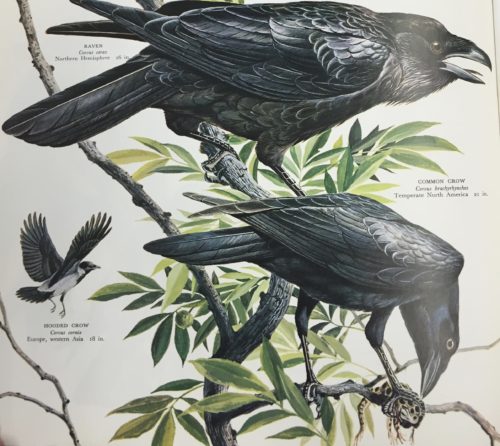The Raven

By Hannah Newell, graduate student in the Institute’s 15th cohort.
When you hear the word raven, what first comes to mind? Do the words deceptive, persistent, clever, noisy or disruptive come to mind? Most often, this is how people have culturally thought of the raven.
Through the early works of Edgar Allen Poe, parts of society have learned to fear the death bringing raven who “Quoth, nevermore” to his dead love Eleanor. What people don’t always know is that the story goes deeper into history. Early cultures around the world have encountered the raven through hunting practices or even at their homes. Hunters from Greenland have been recorded using ravens as a beacon for finding herds of caribou as they were associated with flying in circles around the herds. Similarly, the Han of the Yukon in Canada went to the length of mimicking their calls in order to attract bears to hunting areas. This learned behavior of the bear acts as an example of cultural knowledge being passed on through the generations of bears, creating a new learned relationship between the bear, the raven and the hunter. The raven, being the one who finds the carcass, the bear who strives for the same carcass by following the raven call, and the hunter who uses the desire of the bear to hunt it for their own needs. Ravens use the exchange of knowledge from generation to generation to transfer understandings of humans, feeding sites and potential threats to either their own brood or to roosting mates.
The relationship between humans and ravens have not always been one of admiration, but as we step into the next generation with science and field biology as a priority in many cultures around the world, the desire to learn about ravens and their complicated social dynamics has grown. When humans begin to learn about their complexity, the raven becomes more interesting and desirable to understand, perpetuating the line of knowledge.
Through the work of biologists such as Bernd Heinrich and John Marzluff, the world has been exposed to some of the learned and innate behaviors of ravens. The majority of their observations have been done through feeding sites as this is where the easiest viewing plays out and where there is exposure to social hierarchies and individual characteristics.
Some of the more interesting conclusions that have been made through these observations is the relationship between the resident pair and any incoming raven. At a feeding site, if a resident pair holds the territory that the carcass is in, any intruding raven will be forced away from the area by the resident pair, but if the singular raven returns with reinforcements, often the resident pair will be forced to submit and allow feeding for the whole group to happen. An interesting point to this is that many times these resident pairs or individual ravens will antagonize each other, but will completely ignore any other bird species.

Throughout the research stage of this project, I was compelled to make my own observations of the resident pairs we have around the Environmental Learning Center and the Diablo Dam. I settled on a nesting pair just below the dam road that made for easy viewing through a spotting scope. Through the observations I made, I learned that these ravens have particular reliable feeding spots that they will visit continuously. They have learned to frequent these spots because of the abundance of mice that get thrown out of the dam building by workers. These same workers have also created a bond with these ravens and will even be protected by them from various wildlife intruders that pose a threat to them.
Ravens are as different individually as humans are in our characteristics. Understanding just one dynamic feeding group will not give you the answers to the whole raven population. But what we are starting to come to terms with is the fact that these birds are not the scary death bringer, tricksters that we still associate with their species. In fact, they can be cunning and clever, but it is their will to survive and socialize that brings those characteristics to the forefront.
First image: Birds of America, John J. Audubon
Second image: Glen Rabena (glenrabena.com)

